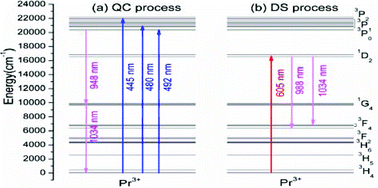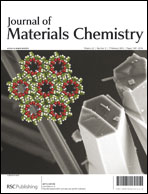A promising dual-mode solar spectral converter CaLaGa3S6O:Ce3+,Pr3+ for Si solar cells has been successfully developed. The structure, photoluminescence excitation and emission spectra in the UV-Vis-NIR region, and the decay curves have been systematically investigated. The results show that CaLaGa3S6O:Ce3+,Pr3+ exhibits two distinct solar spectral converting behaviors, quantum cutting (QC) (3PJ = 0,1,2 → 1G4 → 3H4) and downshift (DS) processes (1D2 → 3FJ = 3,4), depending on different excited levels of Pr3+ and Ce3+. It can almost harvest UV-blue-red (250–625 nm) photons, greatly enhancing the utilization of solar spectrum especially in UV-Vis spectrum region, and convert into an intense broad NIR emission (930–1060 nm), perfectly matching the maximum spectral response of Si solar cells. We demonstrate that Ce3+/Pr3+ ions can form an efficient donor–acceptor pair, with high potential as full spectrum solar converter for Si solar cells, and Ce3+ ion can be an efficient sensitizer for harvesting UV photon and greatly enhancing the NIR emission of Pr3+ ion through efficient energy feeding by allowed 4f–5d absorption of Ce3+ ion with high oscillator strength. The NIR integrated emission intensity of CaLaGa3S6O:Ce3+,Pr3+ is 7.78 times as intense as that of a NIR quantum cutting phosphor Ca2BO3Cl:Ce3+,Tb3+,Yb3+ (CBC). We believe this new dual-mode solar spectral converter may open a new route to the design of advanced UV-Vis–NIR phosphors for Si based solar cell applications.


 Please wait while we load your content...
Please wait while we load your content...